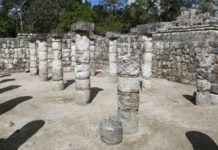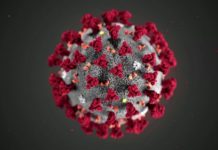KABUL, Afghanistan — For the first time, the Taliban have confirmed the death of Jalaluddin Haqqani, an American ally from the Cold War who later turned his weapons against the United States as the founder of the feared Haqqani militant network, behind some of the deadliest attacks of the 17-year Afghan war.
In their announcement on Tuesday, the Taliban gave no details on the timing of Mr. Haqqani’s death. Throughout his 70s, he remained ill even as his followers continued in his name to stage huge bombings and suicide commando attacks in Afghan cities.
“Mawlawi Jalaluddin Haqqani was ill and bedridden for the past several years,” the Taliban statement said.
Afghan officials have maintained that Mr. Haqqani has been dead for at least four years — an assertion confirmed by one aide to Mr. Haqqani in 2015 — and that the Taliban have waited to use that news at some opportune moment.
One senior Afghan official said the death announcement now was probably related to a planned visit this week to Pakistan by senior American officials, including Secretary of State Mike Pompeo, who are seeking an end to the Afghan war.
The Trump administration has cranked up pressure on Pakistan to end its support and safe haven to the leaders of the insurgency fighting in Afghanistan. Last week, the administration officially canceled $300 million in payments to Pakistan.
Mr. Haqqani’s wing of the Afghan Taliban used to be somewhat autonomous from the insurgency’s main leadership. But in recent years, any separation from the Taliban that might once have existed has been closed. Mr. Haqqani’s son, Sirajuddin Haqqani, has been the insurgency’s deputy leader in title and its military operational leader in truth since 2015.
The Haqqanis’ rise within the Afghan Taliban has also been seen as evidence of the Pakistani military’s continued influence within the insurgency next door. American officials have long considered Jalaluddin and Sirajuddin Haqqani to be among the closest proxies for Pakistan’s military spy agency, Inter-Services Intelligence, known as the ISI.
That relationship was forged in the 1980s, when Jalaluddin Haqqani and the ISI both were favored allies of the United States as it supported the mujahedeen uprising against the Soviet occupation of Afghanistan. C.I.A. funding gave the Haqqani network an early lift.
But after the Americans became the invaders in Afghanistan in 2001, Mr. Haqqani, with his extensive funding networks in the Middle East intact, established his group as a feared wing of the new Taliban insurgency.
Mr. Haqqani was originally from Paktia Province, in Afghanistan near the border with Pakistan. The loyalty networks he formed in the region, on both sides of the border, were a particular advantage both in criminal activities and his aid to insurgencies.
After the mujahedeen captured Kabul, Mr. Haqqani became a cabinet minister of their chaotic government. But the Taliban soon overran the anarchy, and Mr. Haqqani switched sides and has remained with them since.
Jawed Kohistani, a former Afghan intelligence official and security analyst, said Mr. Haqqani had largely taken a symbolic role since his illness grew worse in 2007.
Mr. Haqqani remained in Miram Shah, in the Pakistani tribal areas of Waziristan, where he mingled with foreign fighters affiliated with Al Qaeda, provided guidance and still maintained his old contacts with Arab countries as his son Sirajuddin ran day-to-day military affairs, officials say.
“In the past 10 years, Jalaluddin was an inactive person. He was not involved in decision and military issues,” Mr. Kohistani said.
Mawlawi Sardar Zadran, a distant relative of Mr. Haqqani, said he had been dealing with hepatitis C that worsened after 2011. Mr. Zadran confirmed that Mr. Haqqani had mostly been based in Miram Shah, Pakistan, until his death a few years ago.
“They kept the news secret because it would negatively affect his supporters — because those who were very loyal to him might not continue fighting after his death,” Mr. Zadran said in a telephone interview.
“The other reason for hiding his death,” he added, “was that they were not able to hold funeral and prayer ceremonies because of the fears of airstrikes and being targeted. So if they had announced that Jalaluddin had died, they would have had to hold ceremonies, which was risky at that time.”
Mr. Zadran played down the possibility that the release of the news was related to the Americans’ visit to Pakistan. He said the Americans probably knew that Mr. Haqqani had been dead for years and that the network was fully in Sirajuddin’s control.
Even as word of his death leaked in 2015, Afghan intelligence intercepts showed that the Taliban were telling Mr. Haqqani’s field commanders that their patriarch remained a member of their central leadership in Quetta and that he was under treatment, Afghan intelligence officials say.
As the Haqqanis have become ever more integral with the Taliban leadership, it has also caused awkwardness for the American effort to restart peace talks with the insurgency. Though the Haqqani network is officially listed as a global terrorist group by the State Department, the Taliban have not been — a distinction made mostly to keep negotiation options open.
That false duality came to issue during the negotiations by the Obama administration to free an American soldier, Bowe Bergdahl, who was being held by the Haqqanis. Taliban fighters delivered Mr. Bergdahl to the Americans in 2014 in return for the release of five former Taliban leaders from the Guantánamo Bay prison camp. But critics of the exchange noted that the deal effectively put the administration in the position of negotiating with terrorists.
The current supreme leader of the Taliban, Mawlawi Haibatullah Akhundzada, is seen as a cleric focused more on religious rulings than politics or the battlefield. That, Afghan and Western officials say, has opened a much larger role for Sirajuddin’s increasing control of the military decision-making.
In addition to the network’s traditional stronghold in the border areas of the east and southeast, Sirajuddin and his men have been involved in planning military attacks in other parts of the country, including the recent siege of Ghazni city.
Western officials say he also sends trusted lieutenants on brief advisory missions to the Taliban in the south of the country, not unlike the role the American forces play with the Afghan army and police.
“The military status of Haqqani Network is that they are in charge of the fighting in the east and most parts of the north region of the country,” Mr. Kohistani said, adding, “They are also in charge of the most dangerous and risky activities of the Taliban.”
Fahim Abed contributed reporting from Kabul, Afghanistan
Source : Nytimes













